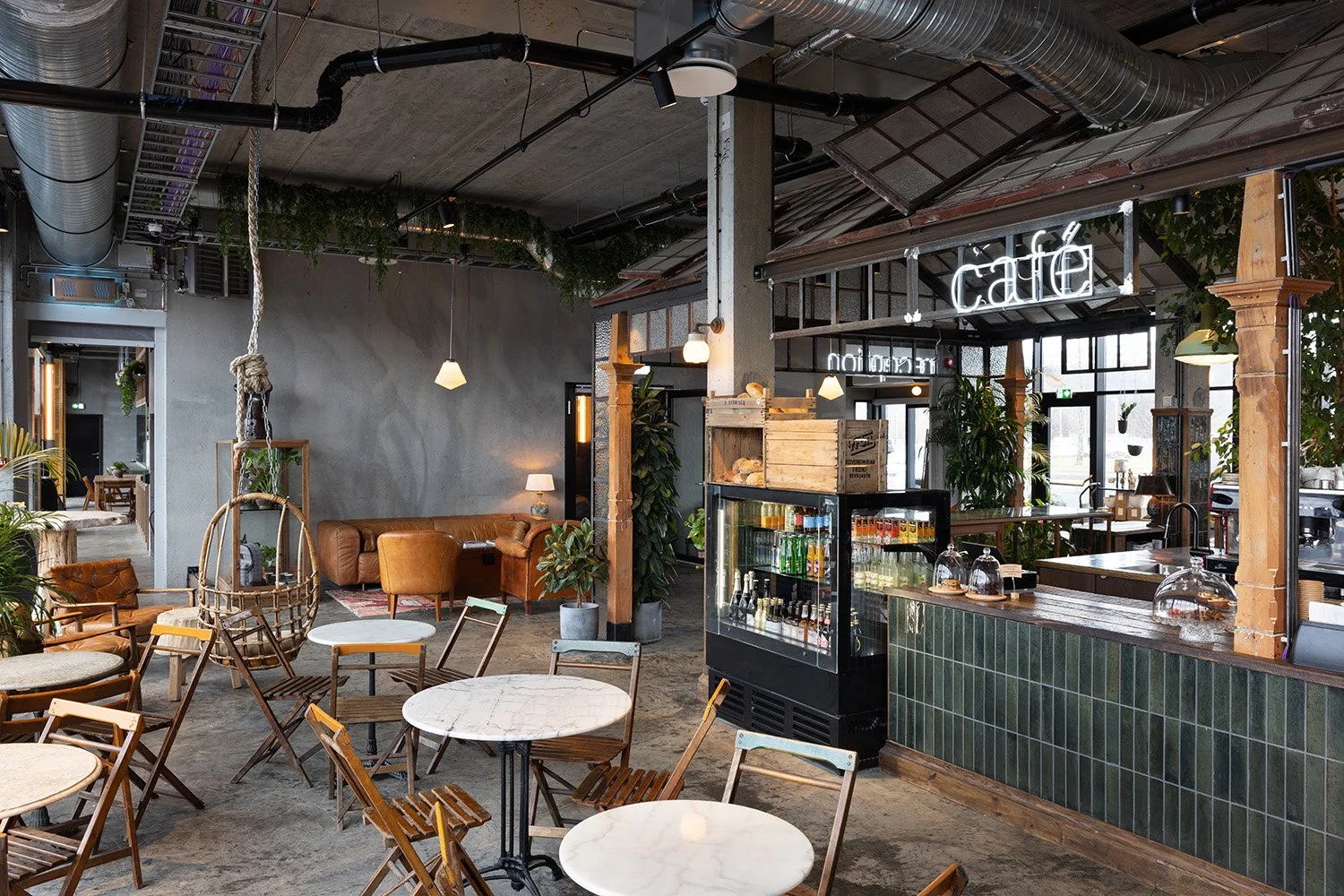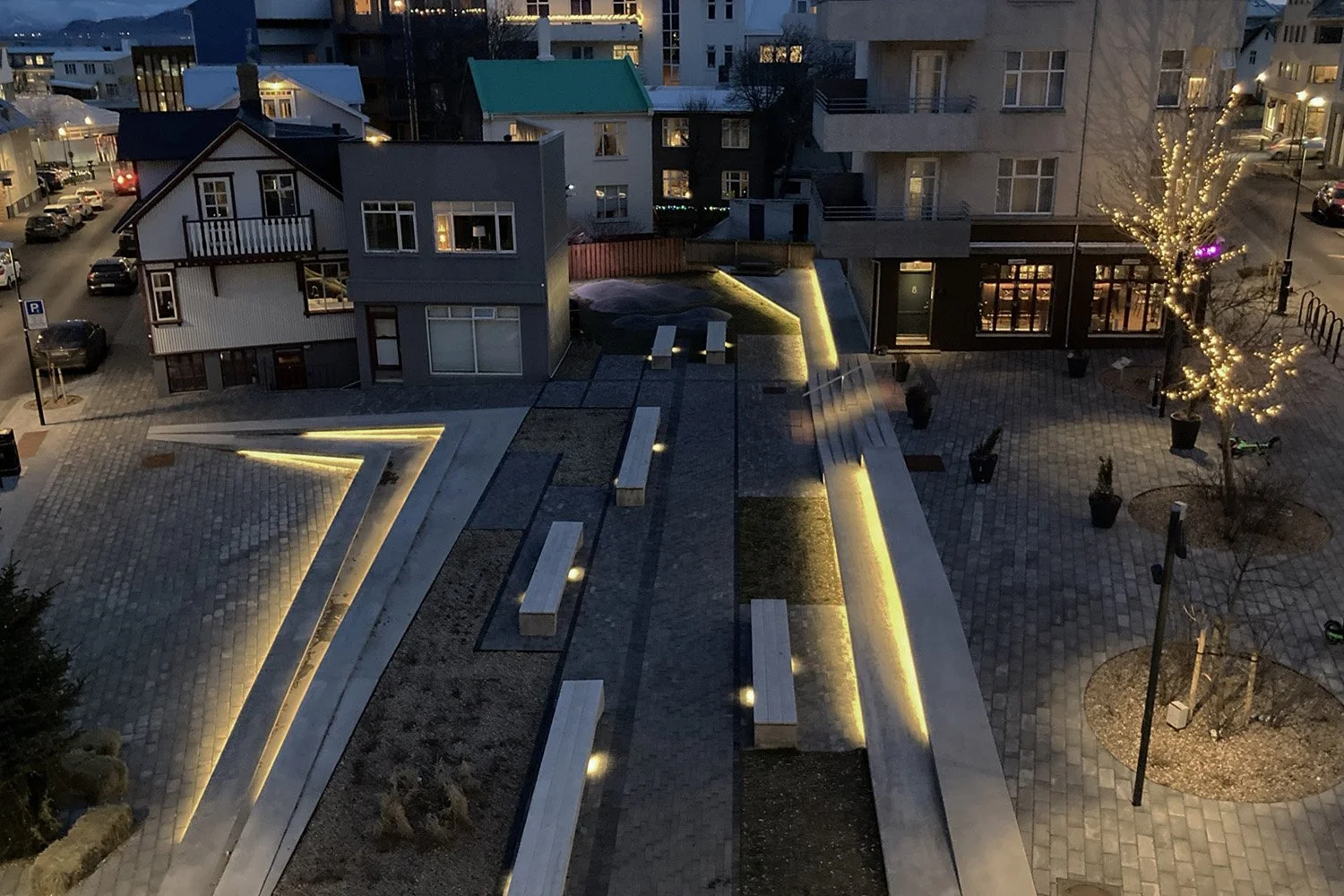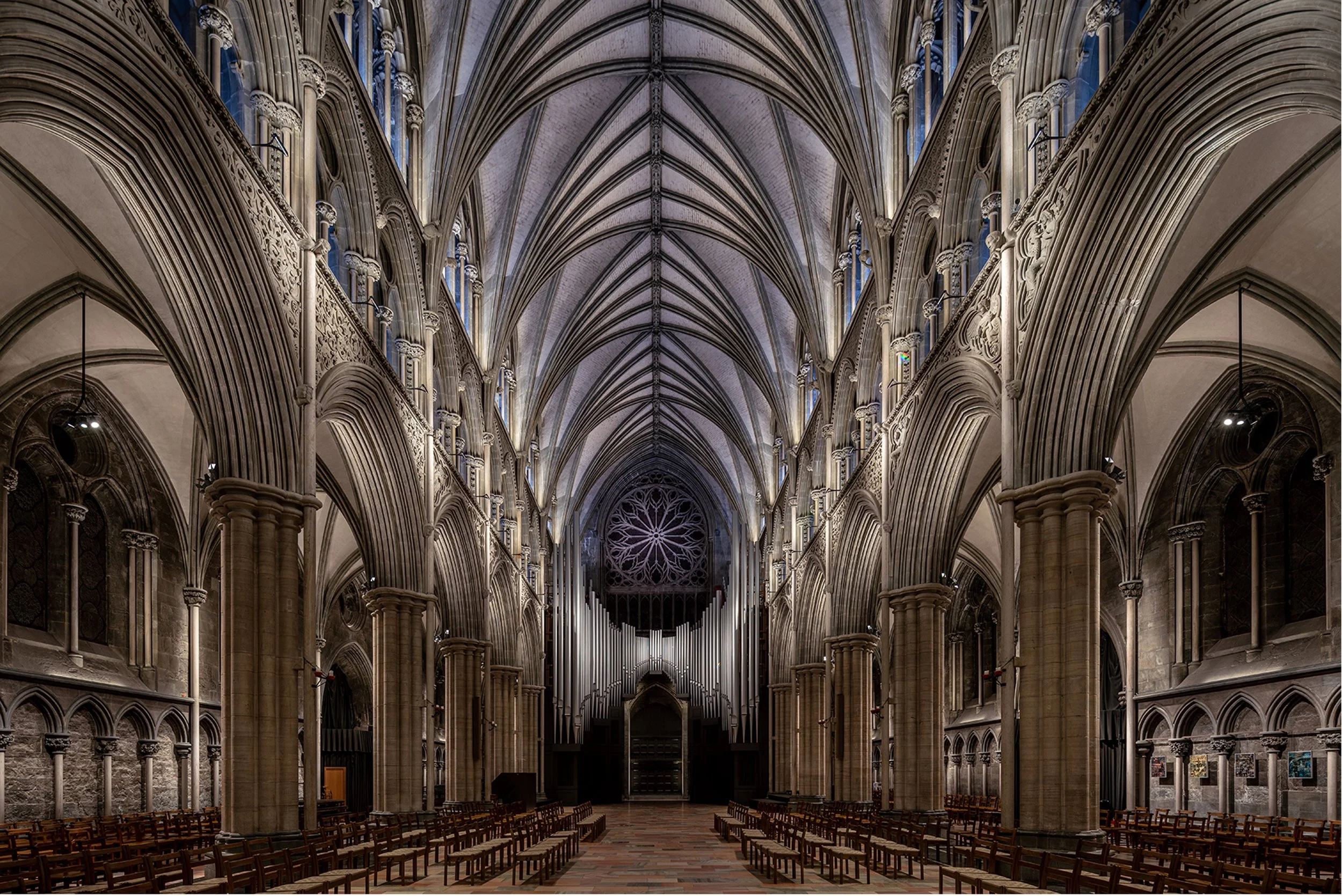Nominated projects 2022
Photo: Roberto Fortuna
Tivoli Hjørnet – Tivoli Corner
Copenhagen - DANMARK
Tivoli Corner is a striking element of the urban space in the center of Copenhagen. The multifunctional building has an area of 8,500 square meters distributed over three floors and houses both the Tivoli Food Hall, Hotel Nimb, meeting rooms, restaurant, roof terrace with outdoor wellness, etc. The large and comprehensive project consists of customized lighting solutions that support the different functional challenges in an exceptional way.
The dynamic glass façade appears almost three-dimensional. The façade lighting changes theme throughout the day and year, one of the themes showing the rhythm of the northern lights and creating a pleasant, universal atmosphere in the busy urban space. The evocation of light colours and their dynamics accentuate the curving glass façade. There is a fine accentuation of the façade lighting and graduation out into the Tivoli Gardens.
The transition from stalls in the food hall, hotel rooms, balcony, patio and the further lighting out into the planting and garden is very convincing. The lighting in the stalls of the Tivoli Food Hall is coordinated for creating harmony between stalls and surroundings. The lighting in the Hotel Nimb is designed individually for each room. Highlights on vertical surfaces of interior walls are balanced so that they do not disturb the façade expression from the outside. Only the reflected light is visible.
On the roof terrace, the green lighting of the swimming pool creates an exotic atmosphere. Overall the light is used as a powerful and precise tool to evoke truly magical atmospheres in a complex context.
Client: Tivoli A/S
Builder: Tivoli A/S
Lighting designer: Jesper Kongshaug
Architect: Pei Cobb Freed & Partners v/Ian Bader
Electrical contractor: Rambøll
Lighting supplier: Zumtobel, Martin, Louis Poulsen, Møller og Rothe, Superlove, Megaman, Kreon og ACDC
Photo: Thomas Simone Maare
Den Brune Kødby
Copenhagen - DANMARK
Den Brune Kødby has a stunning night sky that sets it apart from many other urban spaces in Copenhagen. The Agency for Culture and Palaces wanted the view to the dark sky to be preserved in the renovation of the lighting. The lighting should be harmonious and stylish in line with the strict classical preferences of the architecture, buildings and urban spaces.
As in a traditional Venetian urban space the illumination of the vertical surfaces is the predominant impression. The luminaires under the roof illuminate the facades from above with soft light in addition to lamps mounted on the façade. The newly designed masts are placed according to historical models. The light decreases towards the center of all the spaces, squares and streets, and everywhere there is a beautiful view of the space and the architecture of the classical facades, discreetly lifted in the night by lights with a low level of illumination. All light sources are warm and friendly to the yellow bricks that has given the area its name. The colour temperature is 2700 K in all luminaires and the colour rendering is high.
A central and unpaved space by the music schools is lit more freely, with colour-changing luminaires and gobos. The aim is to create show lighting for outdoor performance.
The light's ability to be reassuring and socially unifying is felt very strongly, especially in the middle of the large and completely dark square in front of Øksnehallen. The area is perceived as a calm oasis in the noise of the surrounding city lights.
Client: Københavns Kommune - Københavns Ejendomme og Indkøb
Builder: Københavns Kommune - Københavns Ejendomme og Indkøb
Lighting designer: Bjarne Schläger Design ApS
Architect: Bjarne Schläger Design ApS
Electrical designer: Gert Carstensen A/S - Rådgivende Ingeniørfirma F.R.I
Electrical contractor: Svend Lajer & Søn El-Anlæg A/S
Lighting supplier: Light Constructor, Signify, Willy Meyer/Delux Denmark og Louis Poulsen
Other essential parties: Slots & Kulturstyrelsen
Photo: Mikael Lundblad
The Greenhouse Hotel
Hveragerði - ISLAND
The design brief was to create a destination hotel on the south coast of Iceland, offering food, drink, shopping, entertainment and accommodation.
The ground floor is split into two areas - the hotel lobby, retail area and a small café on one end and a food hall with six different vendors, hotel bar and lounge on the other.
The overall design concept is colonial style interior, heavy in plants and vegetation. The hotel is located in a geothermal area known and loved as the epicentre of greenhouses built to grow fruit, vegetable, plants and flowers.
The lighting design accommodates the varied functionality of the interior. The retail area is lit with track and spot system for maximum flexibility, while the hotel bar lighting is based on low level table and floor luminaires. The main lighting in the food hall is from hanging linear pendants, that give non focused illumination throughout the seating area, as the table arrangement varies.
As a common denominator throughout the ground floor, same type wall mounted luminaires were used throughout, as well as fixed ornamental luminaires that highlight various elements. Neon was used as signage in selected locations.
Majority of the luminaires were bought used and then restored. Some were just re-wired, while others had a complete makeover to make them fit for commercial use and to add controllability.
All luminaires are controlled via Casambi control system and their state changes automatically throughout the day.
Client: Austurmork
Builder: Tresmidja Roberts
Lighting designer: Arora Lighting Design
Architect: AOK Architects
Interior designer: Bauhus
Electrical designer: Straumvit
Electrical contractor: Straumvit
Lighting supplier: Rafkaup, 360 Volt, RB Technik, Lampar, Sygns GmbH
Photo: Darío Gustavo Núñez Salazar
Óðinstorg
Reykjavík - ISLAND
Óðinstorg square is located in the heart of Reykjavík, but it was not used previously as an open urban space, but rather as a parking lot. The approach to this project was not only illumination, but rather a more holistic vision of this area for the night. This nightscape vision carefully reviewed all elements that will compose the project’s night-time experience.
Following this vision, the lighting strategy used the elements composing the urban and landscape design and looked for every opportunity to integrate lighting into them. The purpose is to create an inviting atmosphere even when the weather challenges you to be outside.
Area lighting was solved by discrete poles that would never compete with the other urban elements. The lighting plan also needed be coherent with the master lighting plan that the City of Reykjavík is currently developing.
The lighting installation is also prepared for future connectivity, all luminaires are digitally addressable. The current programming runs different scenes depending on the season, and specific time of the day. But lighting control system and installation is well prepared for future needs.
Quote from interview:
“We wanted the light to flow ‘naturally’ from the landscape features. And if really needed, light poles and luminaires would have to be as discreet as possible. This is also to be coherent with the future changes that the city of Reykjavík is making regarding the master lighting plan for the city. We wanted to bring light to the area, without luminaires.”
Client: Reykjavíkurborg
Builder: Bjossi ehf.
Lighting designer: Verkís
Architect: Basal Architects
Interior designer: N/A
Electrical designer: Verkís
Electrical contractor: EL-X
Lighting supplier: iGuzzini, Light-Graphix (Rafkaup)
Other essential parties: Edda Ívarsdóttir / Anna María Bógadóttir / Auður Sveinsdóttir
Photo: Tuomas Uusheimo
Kirkkonummi Main Library Fyyri
Kirkkonummi - FINLAND
KIRKKONUMMI MAIN LIBRARY FYYRI
The library project involved the renovation of the old library building completed in 1982, and an extension that doubled the size of the building to 5,000 gross square metres. The client was the Municipality of Kirkkonummi.
The lighting design, seamlessly integrated into the architecture, is based on the architect's vision and interior design solutions. Fyyri combines architecture, design, art and lighting to create a holistic experience.
COMBINING LIGHTING DESIGN AND INTERIOR SOLUTIONS
The multifaceted building has large and high spaces in the new part, low and intimate spaces in the old, and many small spaces. There was no ready-made lighting solution that would have tied the whole together. That is why we decided to design a custom lighting system to suit the space.
The leitmotif of the LED lighting was the wall-, pendant-, floor-, bookshelf- and table luminaires designed for the building, which complement the general lighting. The lighting design was based on grace and simplicity. The special brass-toned luminaires, designed as part of the interior design, were made on the basis of lighting calculations produced in the lighting design. Generic light distributions have been used in the lighting design, and special luminaires have been manufactured for the project.
FUNCTIONALITY AND AMBIENCE OF THE PREMISES TAKEN INTO ACCOUNT IN THE LIGHTING DESIGN
The spaces dedicated to the different activities have been designed to provide sufficient light, but in such a way that the interior design and ambience create visually interesting spaces for different user groups, such as children and young people. The vertical surfaces of the sky lights in the children's section have been accentuated with light, creating an atmosphere that emphasises the architectural features of the space.
The lighting design does not compromise on visual comfort and EN Standard’s recommendations. The light is planned for different activities such as working at terminals and reading books and magazines. In the quiet reading room, the lighting is focused on the reading area, creating an intimate atmosphere in combination with the dark wall surfaces. In addition to the library, the building also houses a café, a music institute, a workers institute, a residents’ park and youth facilities. Fyyri's facilities serve different user groups In a very diverse way.
Client: Municipality of Kirkkonummi
Builder: SRV Oy
Lighting designer: Ramboll Finland Oy, Kaisa Lindstedt
Architect: JKMM, Teemu Kurkela , Jukka Mäkinen
Interior designer: JKMM, Tiina Rytkönen
Electrical designer: Ramboll Finland Oy & Techniplan Oy
Electrical contractor: Sähkö Oy, Helsinki
Lighting supplier: Custom made luminaires - Saas Instruments, Standard luminaires – Bega, Glamox, Iguzzini, XAL, Lival, Fagerhult, Sylvania, Airam, Ensto, Osram, Alppilux, Decorative luminaires – Artek, Ellis Ellis, David Trubridge Outdoor luminaires Saas Instruments, Schréder
Other essential parties: Artwork – Dr Design Petri Vainio
Photo: Skyfox, Marko Kallio
Tammerkoski landscape lighting
Tammerfors - FINLAND
Tammerkoski rapids - Industrial Heritage Reimagined. One of the most iconic cityscapes in Finland, Tammerkoski rapids represent 250 years of Finnish industrial history. Lined with monumental factories and other landmark buildings, the design team’s assignment was to rethink, modernize and expand upon the outdated lighting adorning this kilometer-long waterway that is quintessential Tampere.
Since most of the buildings along the rapids – as well as the area as a whole – are historic landmarks protected by law, it was crucial that the lighting wasn’t too dominant, overpowering the treasured scenery. Thus focusing on refined rather than flamboyant design choices, each structure was carefully highlighted in a way that best complimented its distinctive characteristics, allowing the venerable buildings to tell their own stories. At the same time, great care was taken to accentuate the three-dimensionality of the rugged stone and brick surfaces, creating a fascinating interplay of light and shadow.
All luminaires were carefully selected for each purpose. Of particular note is the Finlayson Factory facade that was illuminated by projecting light through gobos from opposite rooftops in order to prevent the light from scattering into the building. While all facades were illuminated with warm white light to ensure a calm and distinguished overall appearance, colored light was used on a few select locations to create slight accents into the landscape.
Another important consideration was how to tie together a kilometer-long area encompassing dozens of edifices, bridges, dams, hydroelectric power plants and other structures. As a unifying theme, a continuous custom-designed string of lights was installed on embankment walls.
Client: City of Tampere
Builder: City of Tampere
Lighting designer: A-insinöörit (LiCon-AT) & WhiteNight Lighting Oy
Electrical designer: A-insinöörit (LiCon-AT)
Electrical contractor: Tampereen Vera Oy, ELTEL Networks Oy
Lighting supplier: WE-EF LEUCHTEN GmbH, Lumenpulse, Simes, Meyer Lighting, Lumilab Oy,
lighting control: e:cue - Osram
Other essential parties: structural engineering: A-Insinöörit
Photo: Skjalg Helmer Vian
Tana bru i Finnmark
Tana - NORWAY
The bridge is treated as a canvas and a sculpture. Spectacular at certain moments, soft and magical at others, quiet and subdued between dynamic intervals. Various dynamic effects appear every hour for 10 minutes when daylight is gone. Between effects, bridge has various static illumination in white.
The illuminated bridge gives the town identity, stimuli, wow effect, proudness and a focus point.
The bridge is a landmark marking the junction where roads between three countries meet. Arriving here, you drive in uninhabited landscape for hours, then the bridge appears.
Conceptually, the idea is to communicate nature and culture in the illumination. Nature - through the idea of dynamic Aurora Borealis. Culture - by presenting the architecture in a narrative expression, such as projecting sami flag colours, on the national sami day.
The composition precisely illuminates each element of the construction. Cables are “mapped” as a low-resolution screen. No glare from any angles. The precise light distribution gives countless possibilities for color- and form combinations.
In the wide landscape around the town, the bridge is a monumental sculpture. The precise light distribution with very narrow beams shining on grey surface, produces a tremendous bright effect. Colors and form are crystal clear, possible to combine in endless variations.
Functional- and effect lighting are seamlessly integrated into the designed railing, designed by the lighting designers and steel construction engineer. All luminaires and connections are easily accessible for effortless maintenance. Controlled and programmed with DMX on advanced software, operated remotely when needed.
Client: Statens Vegvesen
Builder: HAK Steel
Lighting designer: Zenisk
Architect: Vegdirektoratet
Electrical designer: Zenisk and Norconsult
Electrical contractor: X5 Elektro
Lighting supplier: Rebel light (GVA lighting) and Stockholm lighting (Pharos control system) Frisen belysning (EWO)
Other essential parties: Lars Grieg Hermansen (Programming)
Photo: Tomasz Majewski
Nidaros Domkirke
Trondheim - NORWAY
Nidaros Cathedral is known as a dark cathedral. The dark soapstone, stained-glass windows, and inadequate lighting have made constructions and details invisible.
New lighting aims to:
Highlight the architecture
Ensure improved functionality
Create atmosphere
Use luminaires with high energy efficiency
The principle of the new lighting is to divide the light into different tasks.
The spatiality of the cathedral is emphasized by using warm-white light on the front of the arches and structures, with cooler light in the back – both provided by LED-strips. The white light also puts focus on the pillars, ornaments, and arches. This creates intimacy -and visualizes the human scale in the interior. On the ground floor, LED-strips crafted especially for this project provide lighting of the window niches. The LED-strips have a 7° lens while measuring only 14mm in height. Spotlights hidden on the triforium provide fill-in light for the ceiling and opposite wall surfaces. Elliptical lenses are used to highlight the main pillars, while narrow angled spotlights mark the reliefs in the triangular wall surfaces between the arches in the nave. The contrast light and fill-in light are adjusted through the control system to get the wanted balance. Almost none of these luminaires are visible from the ground floor.
Reading light directed to the floor was challenging without causing glare and without the visible installations becoming too dominant. This is solved by small modest linear spotlights. The special optics hide direct light from view – only a short distance away. The extensions from the triforium floor are specially designed and forged in the cathedral workshops. Another hand-crafted pendant is mounted in the arches of the aisles, providing light for both reading, pillars and ornaments.
Sacral lighting.
In addition to dimming the lighting for contemplation, a spiritual space is created by the light on the sacral elements and -symbols.
Special rigs
For special artistic performances, movable washers have been mounted on extendable rigs in the nave, chancel, and transept. In addition, there are washers and profile luminaires highlighting the main rose window, tower arches and octagon. The luminaire positions, dimming, focus and color can be adjusted from a lighting control console. The most common scenarios have pre-programmed buttons.
Programming and control
All luminaires can be controlled individually, giving great possibilities for energy saving. The control system offers easy operation from a command panel. Here the most important lighting scenarios can be chosen – both for use at church services and special, dynamic programs for Midnight-mass, candle-light evening service and Easter-vigil. For concerts and other cultural events, it is possible to access the entire light management system with external light control consoles. Restrictions are placed on the use of colored light, in honor of the sacred space.
Lighting design: Erik Selmer, IALD, Erik Selmer, Architect MNAL. Lighting Designer IALD
Project Owner and Administration: Bjørgvin Thorsteinsson, Director,
Marie Louise Anker, Special Director, project manager
Nidaros Domkirkes Restaureringsarbeider (Nidaros Cathedral Workshops)
Operation and Security Manager: Jan Tøndelstrand, Workshop coordination Odd Inge Holmberget and Henning Grøtt
Electrical Engineering: Silje Ausen Årseth, SWECO Norge AS
Systemdesign and programming: Sivert Lundstrøm, Luxmentor
Installation: Espen Remen Sæther, NTE Elektro AS
Suppliers: Per Arne Helberget, Luminator
Sub-suppliers: Stokkan Lys, Atendi AS
Foto: Måns Berg
Microsoft office
Stockholm - SWEDEN
In 2019 Microsoft moved into their new office in Stockholm city. The aim was to build a creative meeting hub that invites collaboration and supports their new activity-based approach -The New Working Life. They wanted to achieve a varied environment in both experience and function, with focus on the local connection and the four seasons of the Nordics. The interior concept 'At home in Stockholm' is based on creating an at-home feeling with people and nature at the center. The natural shifts in light and colours throughout the seasons have been an inspiration for both the interior and the lighting.
The office is divided into four different zones; focus, energy, collaboration and exploration, each with a distinctive function and representing one of the four seasons. Colors, textures and materials have been lit with different color temperatures, intensities and lighting principles to allow the seasons to be reflected in the various environments. The lighting has been divided into three layers; general, ambient and effect. For general lighting, we have worked with a high quality, soft, high -contrast light. The ambiance lighting consists of intimate, extra warm elements that create a cozy feeling. The effect lighting adds an element of ‘wow’ where, with the help of light and material, we have created an experience beyond the ordinary that captures the viewer's curiosity.
By using light in symbiosis with materiality we wanted to demonstrate the important role of light as a mood creator and the last layer that brings the concept to reality.
Lighting designer: Paloma Design Studio
Architect: MER Arkitekter
Interior designer: MER Arkitekter
Electrical designer: Tjuren
Electrical contractor: K4
Lighting supplier: XAL, Zero, Modular, Maxel, Fagerhult, iGuzzini, Rebel light
Photo Patrik Gunnar Helin, Studio Ketchup
The City Gate Karlshamn
Karlshamn - SWEDEN
- The gate to the coastal town, Karlshamn, in the Swedish archipelago of Blekinge, runs through Hinse Mountain and its tunnel, leading the visitor directly to the picturesque city core. The design brief was to create a scenic drama, a magic narrative of the Mountain troll with his golden abode and hidden gems, giving a breath-taking first impression for visitors as well as an aesthetic everyday experience for the daily commuters. This gigantic landmark sculpted in light, endorses the identity of the town and region.
The morphology of the mountain and its natural shifting nuances generated the design method. A wide range of luminaries with different intensity and distribution, as well as meticulous positioning was needed in order to sculpt the giant. The tunnel of gems, changes scenarios in amber, gold, rock-crystal and lava, by day and by season, utilization both RGBA and RGBW colour-mixing. This intensifies the experience of the Nordic seasons; rock-crystal shines through the bright summer nights, gold and amber sparkle through the winter holidays. All lighting is controlled in order to make energy saving during night-time.
The functional lighting along the bicycle path and the road lighting in the tunnel works in symbiosis with the architectural lighting of the mountain and of the interior of the tunnel. The distribution and intensity of the functional light is carefully balanced and fine-tuned, well shielded in order for the architectural lighting to be the focus of attention. Whether walking, biking or driving your car the experience is a truly magical.
Client: Karlshamn municipality; Marie-Louise Svensson Wickström, Jonas Johansson, Christer Martinsson
Lighting design: WSP Ljusdesign;
Lead: Vivi Katarina Hennig Ruberg with team: Micaela Pärsdotter Andersson, Åsa Gullstrand, Lars-Magnus Olsson
Electrical designer: WSP Systems; Nicklas Berndtsson and Marcus Hägelmark
Electrical contractor: ELCOM, Elinstallationer i Karlshamn AB
Lighting suppliers: ERCO, Meyer, Fagerhult, GVA/Rebel, Moramast
Programming: Control-Dept.; Daniel Andersson










